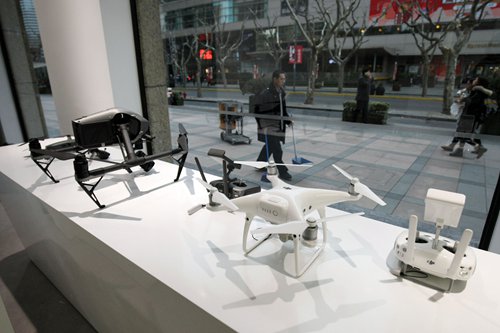


Three drones are on window display at a DJI store in Shanghai. Photo: IC
An unlicensed hobbyist used his unmanned aerial vehicle (UAV), or drone, to film airplanes landing in an airport in Hangzhou, East China's Zhejiang Province, from a few kilometers away, but after the footage he posted online went viral he was met with condemnation for this reckless.
The civil aviation authority's official Weibo account shared the video clips on Sunday, warning that "it violated laws, and such a close distance constituted a substantial threat to the safety of the passengers and the civil plane."
The hobbyist was identified as Yuan, a 23-year-old Hangzhou resident, according to a bulletin issued by the Zhejiang public security department on Monday.
Yuan's drone was about 8.5 kilometers from Hangzhou International Airport, 450 meters above the ground, and it recorded more than one aircraft landing in its 10-minute flight, said the police.
Yuan purchased his drone in December 2016, choosing a model named Mavic Pro made by DJI, a Chinese drone manufacturing giant based in Shenzhen, South China's Guangdong Province, according to the police.
The investigation is still going on and no punishment for Yuan has been announced as of press time.
More than 4,000 net users commented on the incident online, with many saying the rules about drones are too vague or even wondering if there are official rules at all.
"We strongly condemn the use of this technology in areas that conflict with the safe and normal operation of manned air traffic," read a DJI statement on the incident sent to the Global Times on Wednesday.
According to the statement, the company "has been asked by the relevant authorities to assist in their investigation of this incident."
Drone license
There are more than 20,000 UAVs in China, but only half of their operators have "driving licenses," Ke Yubao, secretary-general of the Aircraft Owners and Pilots Association of China (AOPA), was quoted as saying by the West China Metropolis Daily on Tuesday.
Recognized by the Civil Aviation Administration of China, the AOPA is the only authority allowed to distribute Civil Unmanned Aircraft System Pilot Certificates - a driving license for drones.
According to interim provisions for UAV pilots, the operators of drones that weigh less than 7 kilograms are not required to have the certificate, but they have to submit their flight plans to the relevant authorities; for those who operate drones over 7 kilograms, a certificate is mandatory.
Most recreational drones are used for leisure and are tricky to regulate, said Wang Zifeng, a UAV expert, noting that one cannot expect users to always do the right thing without being told what a right thing is, and therefore a regulatory framework for flying locations and heights is necessary.
Zhang Qihuai, deputy head of the Chinese Aviation Law Association, suggested that a real-name purchase mechanism should be introduced to help trace law-breaking drones.
Echoing Zhang Qihuai, Zhang Xueqiao, a deputy procurator general of the Zhejiang procuratorate, told news site thepaper.com on Tuesday that it is imperative to register the information of the buyer with the authorities when they purchase such unmanned aircraft to help identify the culprit when things go south.
He also suggested establishing special regulations and laws that clearly draw definite lines in terms of heights and air zones according to different locations.
Sensitive areas including those of political, economic and military importance should be off limits, and violators should be harshly punished, he noted.
Fancy technology
In fact, how to manage these drones is a worldwide headache.
According to data provided by thepaper.com, from December 2013 to September 2015, there were 327 incidents in the world where drones came dangerously close to civil planes, and in 28 cases, the aircraft had to alter their path to avoid a collision.
A DJI employee named Zhang Fanxi told the Global Times on Wednesday that the company is stepping up efforts to regulate its customers' behaviors by innovating with "new recourses and technologies, such as automatic dependent surveillance - broadcast (ADS-B) receiver."
The ADS-B receiver, together with DJI's satellite-based geofencing system, will help operators avoid entering no-flight zones in a bid to protect sensitive areas and for the sake of safety, said Fancy.
Any future law or policy should be in accordance to China's own situation, and the standards should be well discussed to avoid excessive strictness, said thepaper.com report.
 Fire brigade in Shanghai holds group wedding
Fire brigade in Shanghai holds group wedding Tourists enjoy ice sculptures in Datan Town, north China
Tourists enjoy ice sculptures in Datan Town, north China Sunset scenery of Dayan Pagoda in Xi'an
Sunset scenery of Dayan Pagoda in Xi'an Tourists have fun at scenic spot in Nanlong Town, NW China
Tourists have fun at scenic spot in Nanlong Town, NW China Harbin attracts tourists by making best use of ice in winter
Harbin attracts tourists by making best use of ice in winter In pics: FIS Alpine Ski Women's World Cup Slalom
In pics: FIS Alpine Ski Women's World Cup Slalom Black-necked cranes rest at reservoir in Lhunzhub County, Lhasa
Black-necked cranes rest at reservoir in Lhunzhub County, Lhasa China's FAST telescope will be available to foreign scientists in April
China's FAST telescope will be available to foreign scientists in April "She power" plays indispensable role in poverty alleviation
"She power" plays indispensable role in poverty alleviation Top 10 world news events of People's Daily in 2020
Top 10 world news events of People's Daily in 2020 Top 10 China news events of People's Daily in 2020
Top 10 China news events of People's Daily in 2020 Top 10 media buzzwords of 2020
Top 10 media buzzwords of 2020 Year-ender:10 major tourism stories of 2020
Year-ender:10 major tourism stories of 2020 No interference in Venezuelan issues
No interference in Venezuelan issues
 Biz prepares for trade spat
Biz prepares for trade spat
 Broadcasting Continent
Broadcasting Continent Australia wins Chinese CEOs as US loses
Australia wins Chinese CEOs as US loses